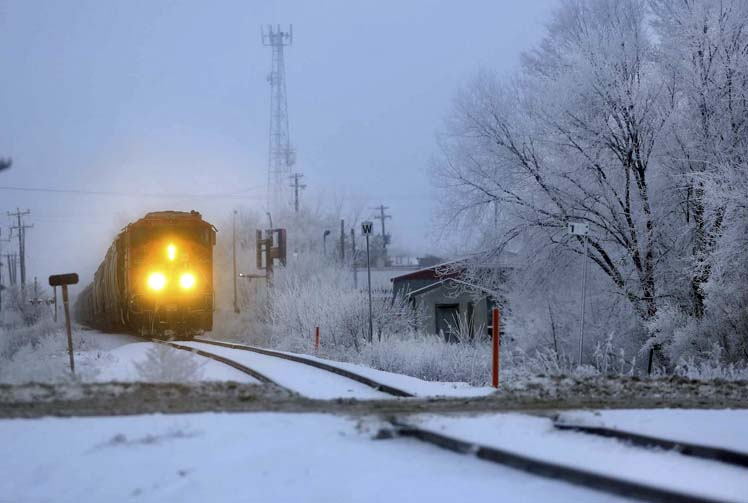
Minnedosa Manitoba - A train carrying more than 100 cars of grain careened down a hill uncontrolled through the southwestern Manitoba town
of Minnedosa last year, the Free Press has learned.
The federal watchdog investigated the runaway train and said the incident showed that Canadian Pacific Railway (CP) staff had been improperly
trained.
The railway said it has rectified the issue.
"In this occurrence, a number of operational actions and decisions were not consistent with regulatory requirements and railway standard operating
procedures," reads a report obtained through an access-to-information request.
The Minnedosa incident involved a grain train, but occurred on a rail line that is increasingly moving petroleum products, as railways make up for stalled
pipeline projects.
That increase has been matched by growing scrutiny of rail safety, after a large CN oil train spill in western Manitoba in February, the same month three CP
employees died in a derailment in the Rockies.
On 1 Jan 2018 a CP train was heading up a hill in Minnedosa, a town of 2,500 people located 50 kilometres north of Brandon, when the crew encountered
difficulty.
A knuckle coupler that links cars had broken, initiating the train's emergency brakes.
The crew fixed the issue, and tried charging the air brakes, but the Transportation Safety Board (TSB) said they didn't allow enough time.
The train moved for one second before pulling apart, possibly because the throttle wasn't correctly set.
The crew went to inspect another broken knuckle, without putting on the handbrakes or retainers, which the safety board said was required under the
situation.
The crew had gotten off the train, standing beside it, despite a rule requiring them to secure the train if they're not physically at the control
panel.
"The crew members believe that, as they were in close proximity to the train, the train was attended, in compliance with" federal rules.
After fixing the knuckle, "the locomotive engineer noted that the remainder of the train was starting to roll uncontrolled downhill (i.e., in the reverse
direction)."
He "attempted unsuccessfully to catch up with (and couple onto) the uncontrolled portion of the train."
Some 112 loaded grain cars and a mid-train locomotive, "rolled uncontrolled for almost a mile," speeding through a flashing-light crossing as well as
one that uses standard railway crossing signs.
It's unclear how fast the train was going.
The safety board censored that information under a confidentiality clause, which the Free Press has appealed.
CP officials refused to reveal the train's speed.
The train stopped on its own.
Prior to the incident, the crew had failed to contact a supervisor to let them know they'd used the emergency brakes, despite that being standard
protocol.
Staff made the wrong decisions despite CP dispatching a senior officer to oversee the repairs.
In March 2018, the safety board reported the incident to the federal regulator, Transport Canada (TC), though a Rail Safety Advisory letter, which is only
issued after serious safety breaches.
The safety board flagged six issues, from improperly securing the train, to not using handbrakes, to not radioing-in that the crew had initiated the emergency
brakes.
It asked TC to review CP's training program and make sure staff understand the rules.
The regulator followed up "and verified the railway was in compliance with rail-safety regulations," wrote spokesman John Cottreau.
"TC also reviewed and accepted CP's response to the (safety board) that outlined actions taken by the railway to address concerns raised in
the Rail Safety Advisory letter."
CP spokesman Jeremy Berry said the incident was "the result of human error and CP took immediate action to educate its employees."
It's unclear if staff members were punished.
Berry said the firm "meets or exceeds all TC regulations," noting its been ranked as the continent's safest large railroad.
"Safety is an ongoing journey, it's not about a single destination. It's a foundational principle, engrained in everything we do, and we recognize that we
must remain vigilant with these efforts and commitments to safety."
Minnedosa Mayor Pat Skatch said CP had promptly reported the incident, and no one was harmed.
"It wasn't an alarming thing that caused people to panic," said Skatch.
"Our community was built around the railroad, and I know there's lots of dangerous goods, but I have full faith in the railroad, that they are looking at
all situations, and keeping that safety is the utmost in their minds."
The safety board has flagged insufficient training in several rail incidents, including one in which a runaway CN train carrying gasoline reached speeds of up
to 48 kph for nearly five kilometres north of Toronto in June 2016.
Dylan Robertson.
provisions in Section 29 of the Canadian
Copyright Modernization Act.

